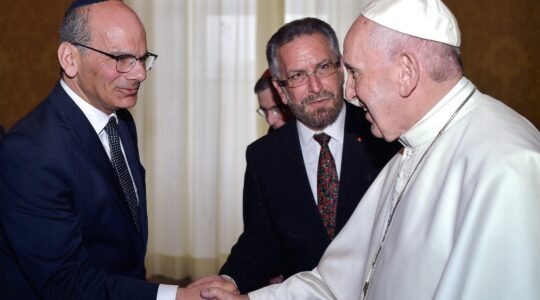JERUSALEM (JTA) – Israel and Syria reopened their diplomatic dialogue this month after a hiatus of eight years. However encouraging this seems in the violence-plagued Middle East, the notion that Israel would have to give Syria the Golan Heights in exchange for a pledge of peace is extremely troubling.
Israel captured the Golan in the 1967 Six-Day War following nearly 20 years in which Syrian forces positioned on the strategic plateau pounded Israel’s farms and towns below with artillery attacks.
Despite advances in military technology, the Golan Heights remains a vital strategic asset for Israel’s defense that Israel cannot afford to cede.
As negotiators will soon find, there are three clusters of issues they will not easily resolve: delineation of an agreed boundary, security arrangements and the Syrian-Iranian alliance. To a large extent, these issues have become even more difficult since negotiations were held in the 1990s.
* Borders: If Syria argues that it is entitled to the pre-1967 lines, there is a fundamental problem because Syria itself illegally occupied territories during the 1950s that were within Israel’s international borders. They are the southern demilitarized zone at al-Hamma, the Banias area and the strip of coastal territory along the northeast shoreline of the Kinneret. When Syrian forces seized the Kinneret shoreline in the 1950s, Damascus declared part of the Kinneret as Syrian territorial waters.
If Israel were to agree to the June 4, 1967 line, essentially it would be rewarding Syrian aggression from the 1950s as well as compromising Israeli control of its largest freshwater reservoir. But Syria is uninterested in anything less.
In any case, Israel should not be arguing with the Syrians over whether a future Israel-Syria boundary should correspond to the June 4, 1967 line or to the older international border because neither of these lines is defensible.
Israel’s positions on the Golan now give its numerically inferior standing army a clear topographical advantage against the masses of Syrian armor deployed in the plain below that stretch all the way to Damascus. As during the 1973 Yom Kippur War, when Israeli armor was outnumbered by a ratio of 8 to 1, this advantage can enable a small Israeli force to hold off a large Syrian advance until Israeli reserve forces can arrive.
It is incorrectly assumed that with the proliferation of ballistic missiles, the holding of actual territory is less important today than in previous generations. In fact, should Syria use its considerable rocket and missile forces against Israel to delay deployment of Israeli reserve forces in the area, the importance of the Golan will increase, as Israel’s small standing army will have to fight for more extended periods of time without reserve reinforcement.
As the Second Lebanon War demonstrated, air power cannot serve as a substitute for effective land warfare if Israel comes under attack.
* Security arrangements: Some proponents of a Golan withdrawal cite the example of the Israel-Egypt peace accord as a model for Syria. In the agreement with Egypt, Israel was compensated for its loss of the Sinai Peninsula with “security arrangements” that fundamentally restricted Egyptian forces in the Sinai through demilitarized areas and limited-forces zones.
But while the Sinai is roughly 120 miles wide, the Golan ranges from 15 to just 7 miles wide. In order to create sufficient security for Israel, it is necessary to institute force limitations on the Syrian army beyond the Golan Heights, well into southern Syria.
Given the proximity of Damascus to the Golan Heights, it is likely that Israel’s security needs for demilitarized zones will require Syria to pull back its armored forces behind its own capital. This indeed was Israel’s position during talks in the 1990s.
This problem is exacerbated by Syria’s massive acquisition of ballistic missiles and rockets, especially after the 2006 Second Lebanon War. Israel must seek to place limitations on these missile forces and on their location close to the Israeli border.
Syria will have to make hard choices regarding the extent of the concessions it must make. Will Syria be willing to accept intrusive security restrictions near its capital, or will it prefer to leave the territorial status quo in place?
* Iran: The Syria-Iran alliance is not just a problem for Israel but for many countries in the Middle East. In Israeli diplomatic circles, the main demand voiced to Syria is breaking its alliance with Iran. But is it reasonable to assume that Syria would be willing to distance itself from Tehran?
Were Syria to cut off from Iran, it would lose its special relationship with Iran’s Shiite proxy in Lebanon, Hezbollah, and with Syria’s own hegemony in Lebanon – a top priority for Syrian foreign policy.
It is extremely unlikely that Syria would be willing to forego this alliance and instead adopt a pro-Western orientation. Iran today is on the move across the Middle East with new achievements in Lebanon, Iraq and the Gulf states. It has a much deeper internal grip on Syria today than it did in the period of Hafez Assad, the father of Syria’s current president, Bashar Assad.
Moreover, even if Syria were willing to signal the beginnings of a move away from Iran, any such changes could be fleeting. While Israel’s concession of the Golan Heights would be irreversible, Syria could shift its regional alignments anytime.
Israeli negotiations with Syria have been part of the Middle East landscape since 1991. But new talks must not be exploited to legitimize a regime that even the Arab world seeks to isolate because of its backing of Iran and its terrorist offshoots.
Moreover, given the continuing military importance of the Golan Heights, it would be a cardinal error for Israel to put into jeopardy its own security by agreeing to come down from this vital strategic barrier.
(Dore Gold is the president of the Jerusalem Center for Public Affairs. As Israel’s ambassador to the United Nations from 1997 to 1999, he dealt with the Syria-Israel negotiating track.)
JTA has documented Jewish history in real-time for over a century. Keep our journalism strong by joining us in supporting independent, award-winning reporting.





